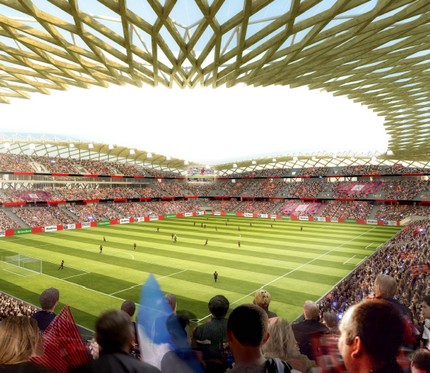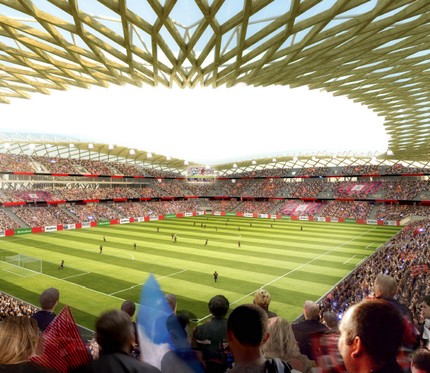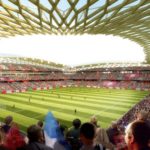Let us remind our readers that Nice-Premium has published a detailed report (which presents characteristics similar to the future Nice stadium and is currently under construction with a planned inauguration in mid-2011). The controversies, following the Municipal Council’s decision to accept the Vinci project, as shown by the statements we publish, are mainly of two types: “the usefulness and relevance of a new Stadium” and “the financial arrangement”.

Regarding the financial aspect, the investment is too expensive. An investment is never too expensive in absolute terms. It is simply necessary to be sure of being able to repay the debts arising from its financing and to determine if the cost/benefit ratio is profitable.
From a formal point of view, there was a call for tenders and an independent commission found that Vinci’s proposal was the best. Up to that point, nothing to say!
Now a stadium is a stadium, there is a standard international cost that can be referenced and there are examples we can compare ourselves to. We chose Juventus Arena because the characteristics of this stadium are truly comparable; that relations with the Municipality of Turin would have been easy to establish for some useful information to better manage a necessarily complex case.
Moreover, if the Nice stadium will certainly be a very “beautiful” stadium in terms of design and construction, the Turin one will be no less so and at a significantly lower cost. Asking those who have succeeded well how they managed or knew how to do it… Was it that difficult?
And to conclude, the financial arrangement of the operation, which is not a PPP/BOT in the orthodox sense of the term, gives the idea of a rather advantageous contract for the concessionaire Vinci which will be reimbursed by the Municipality for the cost of the operation, having the responsibility, but especially the advantage, of operating the sports activities and not of the Stadium and the adjacent commercial part. The supposed beneficiary OGCN will only derive a partial benefit from this presumed gift because its budget may increase by a few million euros given the anticipated result (estimated at 6 million net considering the increased costs and improved revenues).
Naturally, a forecast must be confirmed by actual facts but, in any case, this result, though positive and certainly useful for its finances, will certainly not be the lever to allow the OGCN to position itself at the top end of French football.
A statement from Patrick Allemand, leader of the Changez d’ère group in municipal opposition.
War of figures and mutual accusations with the mayor of Nice. Who tells the truth?
Following the statements of Christian ESTROSI during the last Municipal Council, suggesting that the Region would participate in the renovation of the Stade Vélodrome in Marseille and not in the construction of the Grand Stade in Nice, Patrick ALLEMAND, 1st Vice-President of the Regional Council, held a press conference to clarify the Region’s position on this matter.
Several times, the Nice socialist leader had announced, with the agreement of President Michel VAUZELLE, that the stadium projects, renovation in Marseille and construction in Nice, would be treated equitably. That is to say, if the Region helped finance the Vélodrome, it would also help the Olympic Nice Stadium. He therefore confirms that the Region will participate in the financing of the Nice stadium. It is President Michel VAUZELLE himself who will announce the amount of aid when he deems it appropriate and especially when the Nice project is fully studied.
“This position should not surprise the people of Nice. As an elected member of the opposition in Nice, I clearly opposed this project but I am republican and the taxpayers in Nice should not suffer from the differences I may have with Christian ESTROSI. Back then, I opposed the route of tram line 1, but once the decision was made, the Region came to help Jaques PEYRAT to the tune of 12 million euros. I do not need to defend this case at the Region since President VAUZELLE is committed to the principle of fairness. The communication campaign started a few days ago by Messrs. Estrosi and Ciotti is therefore unnecessary. It is unworthy and moreover false. The two demand the same help as that the Region will give to Marseille, namely 20 million euros. But this figure is false. In a press release on December 16, 2010, Michel VAUZELLE and Jean-Claude GAUDIN committed to a partnership for the renovation of Stade Vélodrome. The Region will intervene to the tune of 10 million euros and not 20 million as Messrs. ESTROSI and CIOTTI implied.
Does fairness mean equality? In any case, Messrs. ESTROSI and CIOTTI do not lack boldness. Indeed, it is useful to recall that when he was Minister, Mr. ESTROSI, while sitting at the council of ministers table with his government friends Eric WOERTH and Rama YADE, obtained only an agreement from the State for 18 million euros for the Nice stadium. Meanwhile, Mr. GAUDIN, who has not been a minister for a long time, managed to obtain a commitment from the State for the renovation of the Vélodrome stadium to the tune of 28 to 30 million euros. In fact, Messrs. ESTROSI and CIOTTI attempt to obtain from the Region what they have not succeeded in obtaining from their own friends.
Press release from the opposition municipal councilors Robert Injey and Emmanuelle Gaziello
Following the municipal council meeting on December 17, where the majority led by Christian Estrosi adopted the Nice-Stadium project, an advertisement about the stadium by the city was published on a double page in Nice-Matin.
The financial setup of this stadium is controversial, and the content of the advertisement is simply deceitful when it states: “The balance (of the total construction cost of 244 million euros) will be covered thanks to the Public-Private Partnership in exchange for a fee paid by the city of Nice, which will be between 6.8 and 7.8 million euros per year”.
This tends to suggest that the fee paid by the city of Nice to the company Vinci would be of that amount and “variable”.
This is completely false. The fee that the city of Nice will pay to Vinci is fixed, and it will amount to 10,835,000 euros excluding taxes for the first full calendar year of operation (2014).
To minimize the enormity of the jackpot that Vinci will rake in over 27 years, and thus the reality of the stadium’s cost to the city, the municipal majority pretends to confuse the amount of this fee and the “net cost,” which is the difference between this fee paid by the city of Nice to Vinci and that which OGC Nice pays to the city of Nice for the use of the stadium.
While the amount of the first payment is certain until the final deadline in November 2040 (!), that which the city of Nice must receive from OGC Nice suffers from two major uncertainties related, each year, to ticket sales revenue and whether OGC Nice plays in Ligue 1 or 2.
The estimate made by the municipal majority is that of a club playing in L1 for 27 years with an average of more than 22,000 spectators per match. As a simple reminder, OGC Nice has spent 10 seasons in L2 over the past 30 years…
Regarding the current stadium attendance, contrary to the figures announced by Mr. Veissière (“last season we had between 11,000 and 16,600 spectators. Official figures”), the reality is quite different. The LNF’s official website gives an average of… 8714 spectators for the 2009/2010 season!
With the Public-Private Partnership project chosen by the mayor of Nice, it is the city of Nice that assumes the total financial burden and sporting risk, and manipulated figures will not hide this reality.
Declaration by Mr. Robert Injey during the Community Council
We are being asked to allocate a competition fund of 6,000,000 for the construction of the Nice Stadium, with an investment amount of 204 ME excluding taxes.
I am not going back over the financial and legal framework; I have had the opportunity to do so during the last municipal council of Nice.
I would just like to dwell on the sporting relevance of such a 35,000-seat facility.
It seems that it will boost attendance. At least that is the argument that your city of Nice’s sports deputy has long developed for us.
I will take his figures and compare them to reality.
First correction: regarding the currently announced attendance by your deputy, it is not “11,000 and 16,600 spectators,” the reality is quite different.
The LNF’s official website gives an average of… 8714 spectators for the 2009/2010 season, and this year it is below that.
Another figure advanced by your deputy, another correction: Grenoble, thanks to its new stadium, has an average of 20,000 spectators even in L2.
The figures from the LNF: Grenoble in L1: an average of 14,000 with a record against OM below 20,000. Grenoble in L2: 5254
The impact of a new stadium on attendance, even when the sports results are there, is not as significant as we are told. An example is Rennes, the season before the new stadium the attendance was 18,246 in 2002-2003
After that, it rises to over 25,000, and it is around 23,000 today. In other words, with positive sports results, the impact of a new stadium is about +30% past the novelty aspect of the initial seasons. Applying 30% to the gym’s attendance gives us not 12,000…
You started this community council by quoting a Latin phrase, I propose to inscribe one on the façade of your future Nice-Stadium: Veni, vidi, Vinci!”



